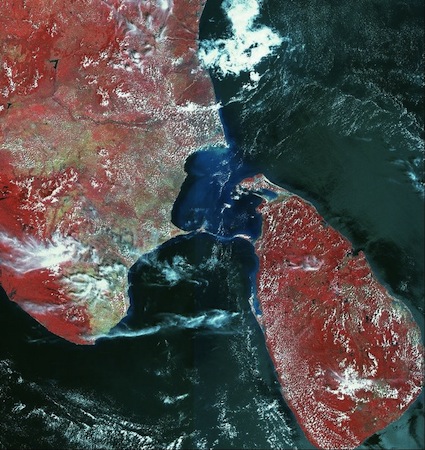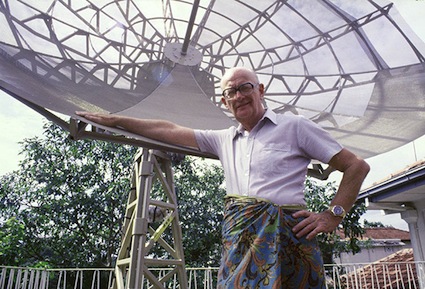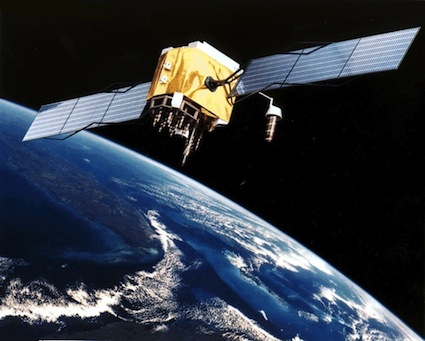It happened 20 years ago, but I still remember the incident. In early 1990, as a young science journalist working for the Asia Technology magazine of Hong Kong, I was being shown around the Pakistani space agency SUPARCO premises in Karachi. At the time, they were readying the country’s first digital communications satellite, Badr 1 (Urdu for ‘New Moon-1’). There was great excitement about its impending launch (which took place a few weeks later on a Chinese Long March 2 rocket).
Being younger, eager and more idealistic, I asked the Pakistani space chiefs if the ‘New Moon’ would also usher in a new era of information disclosure for the hitherto secretive space programme. Pakistan had recently returned to civilian rule after many years of dictatorship, and Benazir Bhutto was Prime Minister (in her first term). The political mood was generally upbeat.
My question only elicited enigmatic smiles. I later found out — from Pakistani journalists and independent scientists — that they weren’t allowed to ask critical questions about the country’s nuclear or space programmes. Or they could ask any questions, but no answers would be forthcoming because that could affect ‘national security’.
The message was clear: democracy or not, some sacred cows always enjoy their privileged status! This has certainly been the case with both the space and nuclear programmes in India and Pakistan: they have been shielded from public and media scrutiny for decades.
For the past few months, it seemed as if we too were following this South Asian tradition. Plans to build Sri Lanka’s own satellites were announced and pursued with little information disclosure and no public debate. The government wanted to launch our very own ‘sacred cows’ into orbit. We the public were to just applaud on cue, and then cough up the money for it…
At least, that was the case until earlier this month. Suddenly, there seems to be a change of heart. In a interview on 6 June 2010 covering a range of issues, head of the Telecom Regulatory Commission (TRC) disclosed that the government was not going ahead with the much-hyped project. At least not in its originally announced form.
Anusha Pelpita, the TRC’s Director General, was quoted as saying: “To set up the satellite, there’s a cost of US$ 20 million. After sending it in orbit, it is US$ 160 to US$ 180 million per annum, which is not feasible.”
He added that the TRC will not proceed with Surrey Satellite Technology Ltd (SSTL), the British firm commissioned to help Sri Lanka to get ready for building and operating its own satellites. The TRC was not averse to launching a satellite per se, but they were ‘exploring other options such as hiring satellites’.
This is the first time in over 15 months that the high costs have been acknowledged. Mr Pelpita gets full credit for being candid and cautious – attributes his agency has not displayed so far in its pursuit of this high-cost, high-tech project. Let’s hope that he will also open up the issue for informed public discussion which has been lacking until now.
LEO and GEO
The satellite project was announced in February 2009 and appeared to gain momentum during the year. Going by official statements and media reports, the plan was to launch not one but two satellites.
The first, to be sent to Low-Earth Orbit (LEO), was an imaging satellite to keep a dedicated eye on our island and the seas around it. Moving somewhere between 160 and 2,000 km above the Earth, it was to help us in both good times (economic activity) and bad (disasters).
The LEO satellite was to be named after the late Sir Arthur C Clarke, the visionary writer who was the first to propose the idea of communications satellites (comsats) back in 1945. The geostationary orbit he calculated for such satellites – invaluable for today’s broadcast and telecom services – lies 36,000 km above the Earth, far higher than the LEOs. (The multibillion dollar comsat industry fondly calls it the ‘Clarke Orbit’. In 2000 Eutelsat, Europe’s leading satellite operator, named one of its comsats in Sir Arthur’s honour.)
Sir Arthur, with whom I worked for 21 years, had his own nickname for LEOs: Anti-Clarke Orbits! Indeed, it seemed a bit incongruous to name a LEO satellite after him. (Despite his well known ego, Sir Arthur never sought personal edifices in his memory. When a journalist once asked him about monuments, he said: “Go to any well-stocked library, and look around…”)
But the TRC decided — without asking the Clarke family or Estate — that the LEO shall be named after Arthur C Clarke. The regulator had its eyes set on the Clarke Orbit too: a second satellite was to be launched there a couple of years later, to be used for ‘broadcasting, communications and high speed Internet’. Its cost? An estimated US$ 100 million (about Rs. 11.3 billion).
Such high price tags never seemed to dampen the enthusiasm of the project’s chief promoter, former TRC chief Priyantha Kariyapperuma. In fact, he envisaged potential savings in the very project where his successor now sees none.
He argued that these satellites would ‘bring about a huge foreign exchange saving’ as Sri Lanka was currently dependent on satellites of other countries for broadcasting, telecommunications and ‘even defence-related information’. No specific figures were given.
Mr Kariyapperuma imagined more ambitious uses for the LEO satellite: “Our Exclusive Economic Zone will probably expand this year from 200 nautical miles to about 800 nautical miles. The most efficient and cost effective way to monitor such a large expanse of ocean will be to use the LEO satellite.”
Curiously enough, the satellite project was being pursued by the telecom regulator despite there being other state agencies mandated to promote various space technologies. These include the Survey Department and Meteorological Department – they have been using internationally sourced satellite imagery and data for decades. Our lives are better and safer for it.
Since that first announcement, the former TRC chief made various statements to the media at regular intervals. We heard, for example:
- Sri Lanka was to set up its own space agency for which a new law was being drawn up.
- The TRC signed a memorandum of understanding (MOU) in November 2009 with SSTL of UK (this is what the new chief now wants to call off).
- TRC was being approached by American and Malaysian satellite operators keen on winning the lucrative contract.
Age of spin
This merry-go-round continued for a full year. The first signs of hesitation emerged in March 2010, when an unnamed TRC official told a journalist that the agency was ‘seriously rethinking’ the satellite project.
He/she was quoted as saying: “We have not decided to go ahead with the project until we figure out whether it’s worthwhile…at the moment we are assessing all options – whether we can lease an existing satellite or if we are to launch, repayment method and pay back period. We have to do this as this is all public funds.” (Emphasis mine.)
To be sure, the TRC is not the only state agency that over-promises and under-delivers. The ICT Agency is another shining example. Vanity and ego-massaging are to be expected in our media-saturated society, but it becomes a serious concern when spin replaces public discussion and debate on national decisions and investments.
We can only guess why the TRC suddenly had a change of mind about the satellite. Maybe its spin doctors will soon explain it away. That would be revealing, but not sufficient.
Meaningful debate can only happen with specific information. Until now, the TRC has not disclosed detailed plans or cost-benefit analyses about this mega project. If these exist, they are not in the public domain.
In this info-vacuum, concerned citizens could ask only top-level questions. As Dr Rohan Samarajiva, a former telecom regulator now heading the ICT policy research organization LIRNEasia urged in mid February 2009:  “Before large amounts of taxpayer money are committed to this project, it would be good to have a broad debate on the pros and cons. I have not been able to identify any pros, but that was not for the lack of trying.”
In his regular column, he also asked (referring to the planned geostationary satellite): “One wonders whether a LKR 11,500,000,000 (11.5 billion) satellite is the highest priority for this little island which seems to be doing pretty well in terms of TV, radio and telecommunications. Satellites are usually required by large continental or archipelagic countries like India and Indonesia.”
The public-funded regulator didn’t respond to these questions from the concerned public. Disappointingly, too, very few others joined the debate. Where are our public intellectuals hiding?
I claim no in-depth expertise in this subject. As a long-standing space enthusiast, I wasn’t convinced this orbital dream was worth its price. So I joined the online discussion, saying: “Building and launching satellites is an expensive business, and operating them once they are in orbit also requires high tech, high cost systems…The bigger issue is what value addition (beyond ego-boosting and chest-thumping) that our own satellite can offer that we cannot commercially buy in the highly competitive satellite services market.”
We were frustrated by the TRC’s complete silence. We were also astonished how the other relevant state agencies – as well as the Ministry of Science and Technology – kept mum when the telecom regulator was encroaching into their areas of expertise.
Charismatic Mega-science?
Astonished, but not really surprised. The silence fitted into a pattern that has been spreading in developing countries for a while. In the late 20th century, many such countries — including some barely able to provide basic needs to their people — started spending scarce public funds on uneconomical ventures such as national cars, national airlines and nuclear reactors. Building one’s own satellite, irrespective of economics, is a continuation of the same practice.
I have called these examples of ‘charismatic mega-science’: exorbitant high-tech ventures that governments love to impose on their people without any public debate. Meant to showcase technological accomplishment, such projects rarely build local capacity or address development priorities. Often they drain funds from health, education or scientific research. In strict cost-benefit terms, many such projects remain white elephants forever. Some are cloaked in secrecy –- real ‘sacred cows’ beyond any criticism or public accountability.
Independent academics, civil society activists and journalists questioning such mega-science projects risk being labelled ‘anti-national’ or ‘anti-development’. (I experienced this last year when I questioned the appalling track record of a government outfit named after Arthur C Clarke which has become a disgrace to the man’s memory. Some ‘reader comments’ sought to shoot the messenger while neatly side-stepping my substantive arguments.)
But let’s be optimistic. Now that the TRC has paused in its orbital adventure, there is yet a chance for good sense to prevail.
The satellite is not the only mega-science project being pursued in post-war Sri Lanka. In June 2009, the Ministry of Science and Technology directed the Atomic Energy Authority to set up a national committee to study technical and financial aspects of setting up a nuclear power plant. Some environmental activists have already expressed concern, highlighting safety and public health risks, high cost of construction and the unresolved problem of nuclear waste disposal. In September 2009, the renowned legal scholar Dr Christopher Weeramantry, former vice president of the International Court of Justice, called for adequate public debate before any final decisions are made.
That debate has also not taken place yet, and there have been surprisingly few voices speaking out. But as long as public funds and public safety are involved, charismatic mega-science projects must take the public into confidence.
Sacred cows – whether orbital or radioactive – can’t be allowed free range.
Science writer Nalaka Gunawardene worked with Sir Arthur Clarke as his research associate for over two decades. He blogs on media, culture and development at: http://movingimages.wordpress.com The views in this essay are entirely his own.



